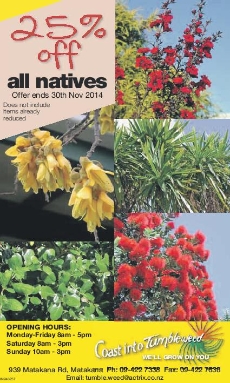
MANGAWHAI'S NO.1 NEWSPAPER
|
|
|
Gardening with Gael - Riparian planting to restore waterways Wishing for ‘an extra day’ or ‘more time’ has almost become a mantra. The days literally flick by as I contemplate all the things I would like to do. Yet another one has cropped up. Wishing for ‘an extra day’ or ‘more time’ has almost become a mantra. The days literally flick by as I contemplate all the things I would like to do. Yet another one has cropped up.My article on the native tree ‘streblus’ elicited a response from the Mangawhai Riparian Group who have recently been planting native trees at the junction of Moir and Tara Roads between the two bridges. There is another big planting further up the river. I would like to arrange time to be part of this group. The intention of the group is a fine one and close to the aspiration of most residents. The idea is to hold back the silt be-fore it washes into the harbour and the waterways. This silt feeds the mangroves which now grow prolifically around the harbour. Slow moving water and silt encourages their growth and the aim of the group is to manage the run-offs at the source by planting native trees around the edge of the public waterways. Their aim is to identify and use the natives which were once established in the area. A workshop at Raglan to witness the progress of the Riparian Society there provided the local group with further inspiration. The riparian areas there are steep and difficult but the success of the group has motivated the local farmers who acknowledge that 17 years of riparian planting in the Raglan area has resulted in increased production. Stock numbers of fish in the neighbouring streams have increased as well. The group witnessed fingers of green belts run-ning up the valleys and clear, clean running water. A follow-up meeting with the Ministry for Primary Industries, DOC and the Northland Regional Council provided the Mangawhai group with avenues of financial help. The group began planting on public land where fingers of the estuary reach Devich Rd. They are extremely grateful to any neighbouring land owners who take an interest in their work. Aid is available to land owners and the group are very happy to offer advice about grants. Simon Vallings of Forest Floor Ltd encouraged the group to buy natives that had been historically in the area. Ngaios [My-oporum laetum] were once very common. When I went to buy some years ago I could only access the Australian variety. Fast-growing, drought resistant and an attractive bright green, ngaios deserve the recognition they are now getting. Twelve streblus have been planted up the bank so their feet don’t get too wet. Flaxes, cabbage trees and carexs are more ideally suited to the wet areas. Manuka, kanuka and a variety of coprosmas provide nursery cover for larger trees which will es-tablish later on. A smaller ribbonwood [Plagianthus divaricatus] which is already growing along the banks has been planted as well. Beautiful ribbons of native flora along clear wa-ter reaches of the estuary would be a lovely addition to our community. By addressing the upper areas, management of the mangroves is more likely to be long-term. The group can be contacted by emailing christine@silvesternz. com. |



